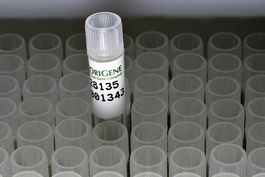CALML5 (NM_017422) Human Tagged ORF Clone
CAT#: RC204372L4
- LentiORF®
Lenti ORF clone of Human calmodulin-like 5 (CALML5), mGFP tagged
"NM_017422" in other vectors (4)
Product Images

Specifications
| Product Data | |
| Type | Human Tagged ORF Clone |
| Tag | mGFP |
| Symbol | CALML5 |
| Synonyms | CLSP |
| Vector | pLenti-C-mGFP-P2A-Puro |
| E. coli Selection | Chloramphenicol (34 ug/mL) |
| Mammalian Cell Selection | Puromycin |
| Sequence Data |
The ORF insert of this clone is exactly the same as(RC204372).
|
| Restriction Sites | SgfI-MluI Cloning Scheme for this gene |
| ACCN | NM_017422 |
| ORF Size | 438 bp |
| OTI Disclaimer | The molecular sequence of this clone aligns with the gene accession number as a point of reference only. However, individual transcript sequences of the same gene can differ through naturally occurring variations (e.g. polymorphisms), each with its own valid existence. This clone is substantially in agreement with the reference, but a complete review of all prevailing variants is recommended prior to use. More info |
| OTI Annotation | This clone was engineered to express the complete ORF with an expression tag. Expression varies depending on the nature of the gene. |
| Reference Data | |
| RefSeq | NM_017422.3, NP_059118.1 |
| RefSeq Size | 893 |
| RefSeq ORF | 441 |
| Locus ID | 51806 |
| Protein Pathways | Alzheimer's disease, Calcium signaling pathway, Glioma, GnRH signaling pathway, Insulin signaling pathway, Long-term potentiation, Melanogenesis, Neurotrophin signaling pathway, Olfactory transduction, Oocyte meiosis, Phosphatidylinositol signaling system, Vascular smooth muscle contraction |
| MW | 15.9 kDa |
| Gene Summary | This gene encodes a novel calcium binding protein expressed in the epidermis and related to the calmodulin family of calcium binding proteins. Functional studies with recombinant protein demonstrate it does bind calcium and undergoes a conformational change when it does so. Abundant expression is detected only in reconstructed epidermis and is restricted to differentiating keratinocytes. In addition, it can associate with transglutaminase 3, shown to be a key enzyme in the terminal differentiation of keratinocytes. [provided by RefSeq, Jul 2008] |
Documents
| Product Manuals |
| FAQs |
| SDS |
Resources
Other Versions
| SKU | Description | Size | Price |
|---|---|---|---|
| SC122857 | CALML5 (untagged)-Human calmodulin-like 5 (CALML5) |
USD 310.00 |
|
| RC204372 | CALML5 (Myc-DDK-tagged)-Human calmodulin-like 5 (CALML5) |
USD 98.00 |
|
| RG204372 | CALML5 (GFP-tagged) - Human calmodulin-like 5 (CALML5) |
USD 460.00 |
|
| RC204372L3 | Lenti ORF clone of Human calmodulin-like 5 (CALML5), Myc-DDK-tagged |
USD 620.00 |
{0} Product Review(s)
Be the first one to submit a review






























































































































































































































































 Germany
Germany
 Japan
Japan
 United Kingdom
United Kingdom
 China
China
